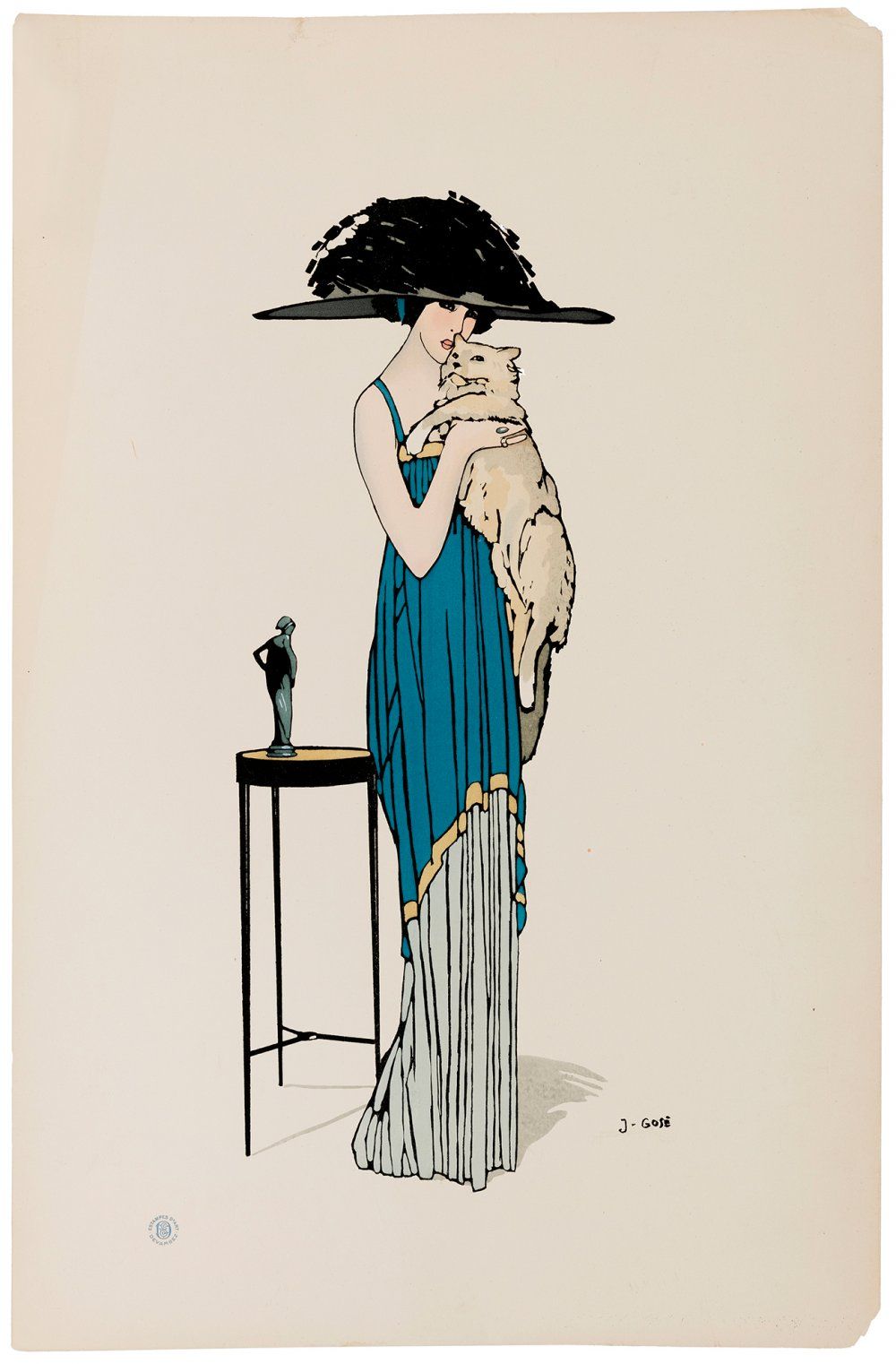Description
FRANCISCO JAVIER GOSÉ ROVIRA (Alcalá de Henares, 1876 - Lleida, 1915). "Lady with cat", 1913. Lithographic poster. Estampes D'Art Devambez. With publisher's stamp. Signed in plate. Work cataloged in "Xavier Gosé, Il.lustrador de la modernitat", Ed. Museu Nacional d'Art de Catalunya (MNAC), 2015, Barcelona, p. 18. Collection: Monografies (Museu Nacional d'Art de Catalunya), 3. Presents some damage, wrinkles and lateral faults of the paper. Measurements: 50 x 35 cm. Javier Gosé's style oscillates between modernism and French art-deco and reflects the life of Parisian society. Inspired by the mundane life of the cafés-concert, the prostitutes, the horse races, the sportsmen and the well-known Montmartre, his style reflects the finesse and delicacy of the French society of the time, although it is not exempt of certain picaresque characteristic of the carefree Paris. Francisco Javier Gosé was an essential draftsman and painter in the graphic world and fashion in the transition from the nineteenth to the twentieth centuries. He studied in Barcelona, where he was assistant to the draftsman José Luis Pellicer. He collaborated from an early age in Barcelona publications, from "La Esquella de la Torratxa", "La saeta", in which it is clear his attachment to modernism, to "Mundial Magazine" and "Fémina", where a pre-cubist line is already beginning to be seen. His first exhibition was held at Els Quatre Gats. During his time in Barcelona he portrayed the proletariat, although in 1900 he traveled to Paris, where he collaborated with "La vie Illustrée", "Le frou-frou", among others. He exhibited in the Barcelona galleries Parés and Dalmau, the Vilches gallery (Madrid), Georges Petit and Ritlinger (both in Paris). Until this moment his works showed a satirical and realistic look on the bourgeois, snobs and prostitutes, although this look changed in 1907, when he began a more stylized, less realistic and less ironic stage, especially because of his beginning in the world of fashion, in which Gosé sought to set a trend among the female society. His time in Paris was the turning point in his life and artistic production, since the French capital was the place where he expanded his knowledge, becoming a successful artist who would get interesting commissions as illustrators in the best satirical magazines. In 1910 he began to collaborate with German magazines such as "Ulk". In 1914 the First World War broke out, a circumstance that, together with the serious health problems he was suffering, deprived him of the elegant Parisian environment, moving to the city of Vichy, famous for its spas. Soon after, Gosé moved back to Barcelona, spending the last days of his life in Lleida. Among the posthumous exhibitions, the Círculo Artístico, the same year of his death, the retrospective at the Rovira Gallery (1970) and the La Caixa Foundation (1984) stand out. He is represented in the Museums of Modern Art in Barcelona and Madrid, among others.
135
FRANCISCO JAVIER GOSÉ ROVIRA (Alcalá de Henares, 1876 - Lleida, 1915). "Lady with cat", 1913. Lithographic poster. Estampes D'Art Devambez. With publisher's stamp. Signed in plate. Work cataloged in "Xavier Gosé, Il.lustrador de la modernitat", Ed. Museu Nacional d'Art de Catalunya (MNAC), 2015, Barcelona, p. 18. Collection: Monografies (Museu Nacional d'Art de Catalunya), 3. Presents some damage, wrinkles and lateral faults of the paper. Measurements: 50 x 35 cm. Javier Gosé's style oscillates between modernism and French art-deco and reflects the life of Parisian society. Inspired by the mundane life of the cafés-concert, the prostitutes, the horse races, the sportsmen and the well-known Montmartre, his style reflects the finesse and delicacy of the French society of the time, although it is not exempt of certain picaresque characteristic of the carefree Paris. Francisco Javier Gosé was an essential draftsman and painter in the graphic world and fashion in the transition from the nineteenth to the twentieth centuries. He studied in Barcelona, where he was assistant to the draftsman José Luis Pellicer. He collaborated from an early age in Barcelona publications, from "La Esquella de la Torratxa", "La saeta", in which it is clear his attachment to modernism, to "Mundial Magazine" and "Fémina", where a pre-cubist line is already beginning to be seen. His first exhibition was held at Els Quatre Gats. During his time in Barcelona he portrayed the proletariat, although in 1900 he traveled to Paris, where he collaborated with "La vie Illustrée", "Le frou-frou", among others. He exhibited in the Barcelona galleries Parés and Dalmau, the Vilches gallery (Madrid), Georges Petit and Ritlinger (both in Paris). Until this moment his works showed a satirical and realistic look on the bourgeois, snobs and prostitutes, although this look changed in 1907, when he began a more stylized, less realistic and less ironic stage, especially because of his beginning in the world of fashion, in which Gosé sought to set a trend among the female society. His time in Paris was the turning point in his life and artistic production, since the French capital was the place where he expanded his knowledge, becoming a successful artist who would get interesting commissions as illustrators in the best satirical magazines. In 1910 he began to collaborate with German magazines such as "Ulk". In 1914 the First World War broke out, a circumstance that, together with the serious health problems he was suffering, deprived him of the elegant Parisian environment, moving to the city of Vichy, famous for its spas. Soon after, Gosé moved back to Barcelona, spending the last days of his life in Lleida. Among the posthumous exhibitions, the Círculo Artístico, the same year of his death, the retrospective at the Rovira Gallery (1970) and the La Caixa Foundation (1984) stand out. He is represented in the Museums of Modern Art in Barcelona and Madrid, among others.
